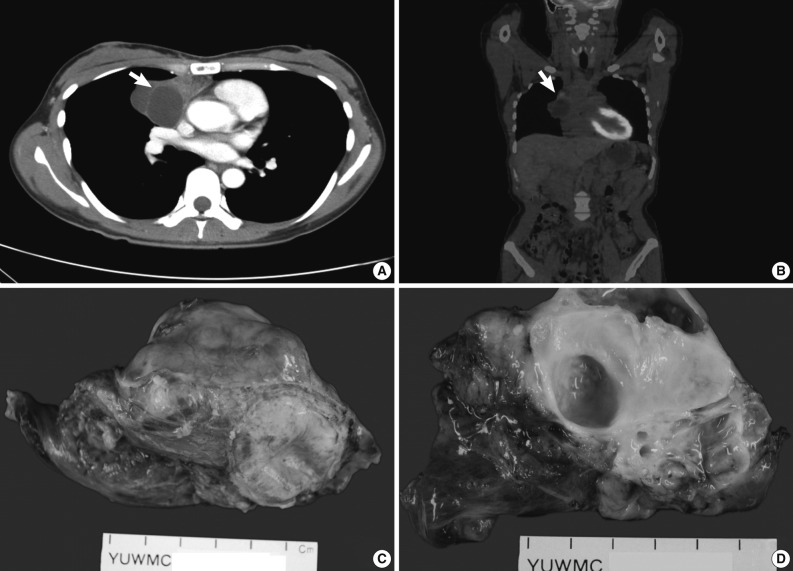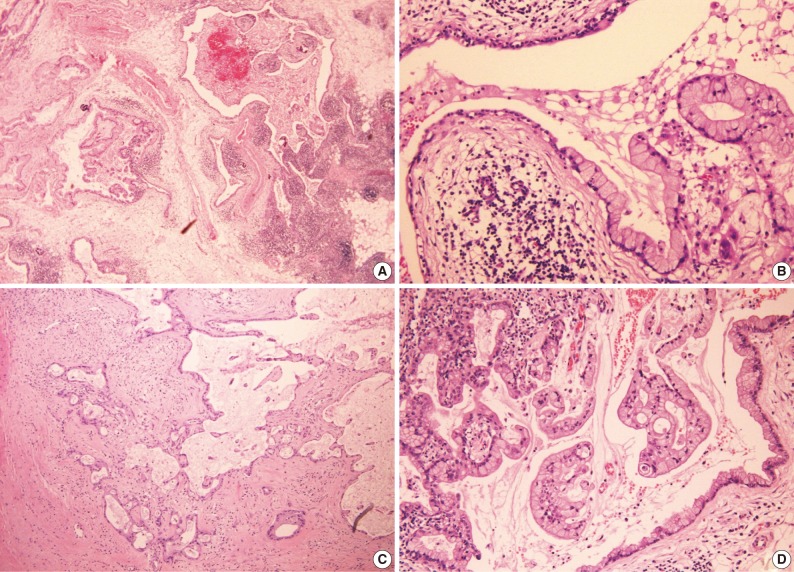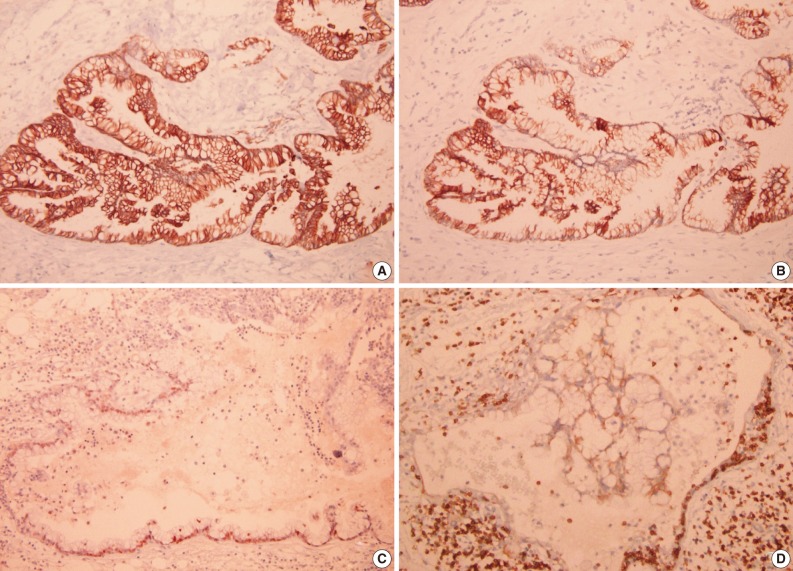Articles
- Page Path
- HOME > J Pathol Transl Med > Volume 46(4); 2012 > Article
-
Case Report
Primary Thymic Mucinous Adenocarcinoma: A Case Report - Jamshid Abdul-Ghafar, Suk-Joong Yong1, Woocheol Kwon2, Il Hwan Park3, Soon-Hee Jung
-
Korean Journal of Pathology 2012;46(4):377-381.
DOI: https://doi.org/10.4132/KoreanJPathol.2012.46.4.377
Published online: August 23, 2012
Department of Pathology, Yonsei University Wonju College of Medicine, Wonju, Korea.
1Department of Internal Medicine, Yonsei University Wonju College of Medicine, Wonju, Korea.
2Department of Radiology, Yonsei University Wonju College of Medicine, Wonju, Korea.
3Department of Thoracic Surgery, Yonsei University Wonju College of Medicine, Wonju, Korea.
- Corresponding Author: Soon-Hee Jung, M.D. Department of Pathology, Yonsei University Wonju College of Medicine, 20 Ilsan-ro, Wonju 220-701, Korea. Tel: +82-33-741-1551, Fax: +82-33-731-6590, soonheej@yonsei.ac.kr
© 2012 The Korean Society of Pathologists/The Korean Society for Cytopathology
This is an Open Access article distributed under the terms of the Creative Commons Attribution Non-Commercial License (http://creativecommons.org/licenses/by-nc/3.0) which permits unrestricted non-commercial use, distribution, and reproduction in any medium, provided the original work is properly cited.
Abstract
- Primary thymic mucinous adenocarcinoma is an extremely rare aggressive subtype of thymic carcinoma. With a review of literatures, only nine cases have been reported up to present. A 36-year-old woman was admitted for further evaluation and treatment of a mediastinal mass. The patient had no medical history of cancer. The clinicoradiological examination disclosed no tumor elsewhere. After the surgical excision of mediastinal mass, it was grossly a round semi-solid mass with mucin-filled cystic areas. Microscopically solid areas showed cords, small nests and dilated glands infiltrating the fibrotic parenchyma, while the cystic areas were lined by mucinous epithelium with tumor cells floating in extracellular-mucin pools. Some cystic walls underwent malignant transformation of the benign thymic epithelium. Immunohistochemically, the tumor cells were positive for cytokeratin (CK) 7, CK20, CD5, and CDX-2, and negative for thyroid transcription factor-1. In conclusion, the mucinous thymic adenocarcinoma should be recognized as a separate histopathological entity and considered in the differential diagnosis of mediastinal carcinomas.
- A 36-year-old woman was admitted to our hospital for further evaluation and treatment of a mediastinal mass. The patient had no notable medical history. On chest radiography and computed tomography (CT) scans, the patient had a round, 5.6×4.4 cm-sized lobulated cystic mass in the anterior mediastium (Fig. 1A). To exclude a metastatic neoplasm to the mediastinum, we performed a comprehensive examination, including a detailed history taking; physical examinations including breast and pelvic examinations; upper and lower gastrointestinal endoscopic examinations; a CT examination of the chest, abdomen and pelvis; and a positron emission tomography and bone scans (Fig. 1B). But this disclosed no evidence of primary tumor elsewhere. The patient received a surgical excision of mediastinal mass, showing that the resected mediastinal mass consisted of a 9×6×5 cm-sized, round, tan-to-white, fairly well-circumscribed, lobulated mass (Fig. 1C). The cut surface revealed multiple, variable sized, multiloculated cysts separated by solid and semi-solid areas. The cysts had smooth walls and were filled with mucinous fluid (Fig. 1D). Microscopically, there was a residual presence of the normal thymic tissue with fatty replacement in the periphery of the lesion (Fig. 2A). The tumor showed solid and cystic areas that are lined by cuboidal to pseudostratified columnar epithelial cells. Some cystic walls underwent malignant transformation from the benign thymic epithelium (Fig. 2B). The solid area showed dilated glands, cords and small nests that infiltrated the fibrotic parenchyma (Fig. 2C). The neoplastic cells were abundant in mucinous cytoplasm with basally-located, mild-to-moderately pleomorphic, slightly hyperchromatic nuclei, which was accompanied by the presence of small nucleoli. In addition, there were also occasional mitoses with atypical forms. There were floating tumor cells in extracellular mucin pools (Fig. 2D). We performed an immunohistochemical staining using antibodies to cytokeratin (CK) 7, CK20, CD5, CDX-2 and thyroid transcription factor-1 (TTF-1) by serving appropriate negative and positive controls. This showed that the tumor cells were diffuse cytoplasmic and membranous positive for CK7, CK20 and focal nuclear positive for CDX-2 (Fig. 3A-C). Some tumor cells and normal thymic tissue were positive for CD5 (Fig. 3D). The primary pulmonary marker, TTF-1, was negative in both tumor cells and normal thymic tissue.
- Postoperatively, the patient was followed up after receiving radical-aimed radiotherapy and chemotherapy (six cycles of Taxol/CDDP regimen). On chest CT scans at a 1-year follow-up, the patient had multiple metastatic nodules in both lungs with malignant pleural effusion. On postoperative month 15, the patient died of disease.
CASE REPORT
- Primary thymic carcinoma is a rare entity that poses a diagnostic challenge for both clinicians and pathologists because of their infrequent occurrence and variable histological features.2 The majority of reported cases of primary thymic carcinomas are squamous cell carcinoma or its variants.6 Of the primary adenocarcinomas, mucinous adenocarcinoma is the rarest histologic subtype. Only nine cases have been documented since it was first reported by Choi et al.4 in 2003.2,3,5-7
- In making a proper diagnosis of primary thymic mucinous adenocarcinoma, the clinicopathologic and radiological findings are needed. Clinically, the tumor should be confined to the anterior mediastinum with no evidence of tumor in other organs.3 Histopathologically, the malignant transformation of benign epithelial cells of the thymic cyst is essential for making a correct diagnosis of the primary thymic adenocarcinoma. These lining epithelial cells, whether they are benign or malignant, are positive for CD5, a marker of thymic epithelial cells. In our case, there was a transitional zone where the CD5-positive, benign epithelial cells lining the cyst underwent malignant transformation.
- Primary mucinous adenocarcinoma of the thymus is a diagnosis of exclusion. On routine microscopic examination alone, the tumor is suggestive of mucinous adenocarcinoma occurring in the gastrointestinal tract, pancreaticobiliary tract, lung, breast and ovary.7 In addition, adenocarcinoma arising in a mediastinal teratoma, thymic carcinoid tumor with prominent mucinous stroma or mucoepidermoid carcinoma should be considered in the differential diagnosis.6 The carcinoid tumor with prominent mucinous stroma is composed of a conventional neuroendocrine morphology such as an organoid pattern and a delicate fibrovascular septum. In establishing a diagnosis as mucoepidermoid carcinoma, the histological findings should include both the squamous and the mucin-producing components. In addition, all the three germ cell layers should also be present for making a diagnosis of mediastinal teratoma. But these findings were not found in our case.
- Presumably, the respiratory tract might be one of the most common primary sites of the occurrence of metastatic mediastinal adenocarcinoma.2 It is known that TTF-1 is a very specific marker for the primary pulmonary adenocarcinoma.6 It is not expressed in cases of thymic mucinous adenocarcinoma. But it is expressed in 77-100% of total cases of pulmonary mucinous adenocarcinoma.2 We think that TTF-1 is a very useful marker for differentiating thymic and primary pulmonary mucinous adenocarcinomas.
- There are no specific immunohistochemical markers for the tumors of thymic origin. CD5, a lymphocytic marker, is expressed in approximately 70% of all cases of thymic adenocarcinoma and it is relatively uncommon in non-thymic carcinomas.6
- Immunostaining for CK7, CK20, and CDX-2 is helpful for the differential diagnosis of mucnious adenocarcinoma from other thymic carcinomas, such as adenocarcinoma with mucinous differentiation arising in a mediastinal teratoma, thymic carcinoid tumor with prominent mucinous stroma or mucoepidermoid carcinoma with mucinous differentiation. However, these immunostains are not helpful for differentiation of primary thymic mucinous adenocarcinomas from metastatic mucinous one. This is due to the positive staining of those markers in pulmonary, gastrointestinal and ovarian mucinous adenocarcinomas. In our case, immunohistochemical stains of tumor cells were diffuse positive for CK7 and CK20; focal positive for CD5 and CDX-2; and negative for TTF-1. These findings are close to those seen in a case reported by Choi et al.4 In our case, the cysts met all the diagnostic criteria for an acquired multilocular thymic cyst.7 It has been postulated that the thymic epithelium would potentially undergo glandular differentiation, as evidenced by the presence of ciliated and mucinous cells in the epithelium of the cysts.4 A rare instance of malignant transformation of thymic cyst had also been described,2-4,7 and it was focally present in our case. It is difficult to describe the prognosis of this rare entity because of a smaller number of cases. It appears, however, that the thymic mucinous adenocarcinoma may behave aggressively than the non-mucinous one.7 With a review of literatures and based on our case, it can be concluded that thymic mucinous adenocarcinoma occurs in relatively young age with an average age of 47 years (range, 15 to 82 years) and with a male-to-female ratio of 1:1. The tumor size is large with an average size of 10.27 cm (range, 5.2 to 14.5 cm) and 50% (5/10) of cases are associated with cystic change. All of the patients with mucinous thymic adenocarcinoma died of disease or had metastatic lesions few months after the diagnosis (Table 1).
- In conclusion, we believe that this aggressive subtype of thymic adenocarcinoma should be regarded as a distinct variant of thymic carcinoma. It is an extremely rare tumor for which a comprehensive, clinical, radiological and pathological work-up should be done to make a correct diagnosis of and to promptly manage it.
DISCUSSION
- 1. Suster S. Thymic carcinoma: update of current diagnostic criteria and histologic types. Semin Diagn Pathol 2005; 22: 198-212. ArticlePubMed
- 2. Maeda D, Ota S, Ikeda S, et al. Mucinous adenocarcinoma of the thymus: a distinct variant of thymic carcinoma. Lung Cancer 2009; 64: 22-27. ArticlePubMed
- 3. Ra SH, Fishbein MC, Baruch-Oren T, et al. Mucinous adenocarcinomas of the thymus: report of 2 cases and review of the literature. Am J Surg Pathol 2007; 31: 1330-1336. PubMed
- 4. Choi WW, Lui YH, Lau WH, Crowley P, Khan A, Chan JK. Adenocarcinoma of the thymus: report of two cases, including a previously undescribed mucinous subtype. Am J Surg Pathol 2003; 27: 124-130. PubMed
- 5. Seki Y, Imaizumi M, Shigemitsu K, Yoshioka H, Ueda Y. Mucinous adenocarcinoma of the anterior mediastinum. Kyobu Geka 2004; 57: 413-416. PubMed
- 6. Takahashi F, Tsuta K, Matsuno Y, et al. Adenocarcinoma of the thymus: mucinous subtype. Hum Pathol 2005; 36: 219-223. ArticlePubMed
- 7. Kapur P, Rakheja D, Bastasch M, Molberg KH, Sarode VR. Primary mucinous adenocarcinoma of the thymus: a case report and review of the literature. Arch Pathol Lab Med 2006; 130: 201-204. ArticlePubMedPDF
- 8. Okuda M, Huang CL, Haba R, Yokomise H. Clear cell carcinoma originating from ectopic thymus. Gen Thorac Cardiovasc Surg 2009; 57: 269-271. ArticlePubMedPDF
- 9. Morikawa H, Tanaka T, Hamaji M, Ueno Y, Hara A. Papillary adenocarcinoma developed in a thymic cyst. Gen Thorac Cardiovasc Surg 2010; 58: 295-297. ArticlePubMedPDF
REFERENCES



Figure & Data
References
Citations

- Unresectable Primary Enteric‐Type Thymic Adenocarcinoma Treated With FOLFOX Chemotherapy: A Case Report
Carl He, Georgia Bentick, Patrick Hosking, Andrew Mant
Cancer Reports.2025;[Epub] CrossRef - Enteric thymic adenocarcinoma: Understanding a unique pathology in the mediastinum
Raja Chhabra, Kartik Mittal, Anmol Tufchi, Sajjan Rajpurohit, Deepak Kumar Mittal, Aditya Vidushi, Swati Saxena, Md Ali Osama
Indian Journal of Pathology and Microbiology.2025; 68(4): 820. CrossRef - Primary mucinous adenocarcinoma of the thymus
Kohei Soejima, Hidehito Matsuoka
The Journal of the Japanese Association for Chest Surgery.2024; 38(6): 545. CrossRef - Stage IV thymic mucinous adenocarcinoma under long-term disease control after primary tumor resection: A case report
Chihaya Maeda, Tomoyuki Hishida, Kyohei Masai, Keisuke Asakura, Katsura Emoto, Hisao Asamura
The Journal of the Japanese Association for Chest Surgery.2022; 36(2): 156. CrossRef - Lenvatinib-refractory thymic mucinous carcinoma with PIK3CA mutation
Akihiro Tsukaguchi, Shoichi Ihara, Hironao Yasuoka, Seigo Minami
International Cancer Conference Journal.2022; 12(1): 36. CrossRef - Thymic mucinous adenocarcinoma: A case report
Hideki Tsubouchi, Naoki Ozeki, Yuka Suzuki, Koji Kawaguchi, Takayuki Fukui, Toyofumi F. Chen-Yoshikawa
The Journal of the Japanese Association for Chest Surgery.2021; 35(5): 547. CrossRef - Metastatic thymic-enteric adenocarcinoma responding to chemoradiation plus anti-angiogenic therapy: A case report
Man Li, Xiao-Yu Pu, Li-Hua Dong, Peng-Yu Chang
World Journal of Clinical Cases.2021; 9(7): 1676. CrossRef - Primary Mucinous Adenocarcinoma of the Thymus: a Rare Type of Thymic Carcinoma—Case Report
Koichi Tomoshige, Tomoshi Tsuchiya, Keitaro Matsumoto, Takuro Miyazaki, Ryoichiro Doi, Ryusuke Machino, Satoshi Mizoguchi, Takamune Matumoto, Yutaka Maeda, Takeshi Nagayasu
SN Comprehensive Clinical Medicine.2021; 3(5): 1233. CrossRef - Primary mucinous adenocarcinoma of the thymus: A case report
Tomoka Hamahiro, Ryo Maeda, Takanori Ayabe, Yuichiro Sato, Masaki Tomita
Respiratory Medicine Case Reports.2021; 34: 101497. CrossRef - Primary Thymic Mucinous Adenocarcinoma: A Case Report Focusing on Radiological Findings and Review of the Literature
Young Hoon Koo, Jae Wook Lee, Jai Soung Park, Kyung Eun Shin, Heon Lee, Susie Chin
Iranian Journal of Radiology.2020;[Epub] CrossRef - Mucinous adenocarcinoma of the thymus: report of a case
Fumihiko Kinoshita, Fumihiro Shoji, Kazuki Takada, Gouji Toyokawa, Tatsuro Okamoto, Tokujiro Yano, Yoshinao Oda, Yoshihiko Maehara
General Thoracic and Cardiovascular Surgery.2018; 66(2): 111. CrossRef - Thymic enteric type adenocarcinoma: A case report with cytological features
Marie Tamai, Mitsuaki Ishida, Yusuke Ebisu, Hisashi Okamoto, Chika Miyasaka, Chisato Ohe, Yoshiko Uemura, Tomohito Saito, Tomohiro Murakawa, Koji Tsuta
Diagnostic Cytopathology.2018; 46(1): 92. CrossRef - Primary thymic adenocarcinomas: a clinicopathological and immunohistochemical study of 16 cases with emphasis on the morphological spectrum of differentiation
Neda Kalhor, Cesar A. Moran
Human Pathology.2018; 74: 73. CrossRef - Histologic characteristics of thymic adenocarcinomas: Clinicopathologic study of a nine-case series and a review of the literature
Ah-Young Kwon, Joungho Han, Jinah Chu, Yong Soo Choi, Byeong-Ho Jeong, Myung-Ju Ahn, Yong Chan Ahn
Pathology - Research and Practice.2017; 213(2): 106. CrossRef - Cytologic Characteristics of Thymic Adenocarcinoma with Enteric Differentiation: A Study of Four Fine-Needle Aspiration Specimens
Ah-Young Kwon, Joungho Han, Hae-yon Cho, Seokhwi Kim, Heejin Bang, Jiyeon Hyeon
Journal of Pathology and Translational Medicine.2017; 51(5): 509. CrossRef - Mucinous cystic tumor with CK20 and CDX2 expression of the thymus: Is this a benign counterpart of adenocarcinoma of the thymus, enteric type?
Jun Akiba, Hiroshi Harada, Shintaro Yokoyama, Toshihiro Hashiguchi, Akihiko Kawahara, Masahiro Mitsuoka, Shinzo Takamori, Hirohisa Yano
Pathology International.2016; 66(1): 29. CrossRef - Colon cancer chemotherapy for a patient with CDX2-expressing metastatic thymic adenocarcinoma: a case report and literature review
Akihiko Sawaki, Mikiya Ishihara, Yuji Kozuka, Hiroyasu Oda, Satoshi Tamaru, Yumiko Sugawara, Yoshiki Yamashita, Toshiro Mizuno, Taizo Shiraishi, Naoyuki Katayama
International Cancer Conference Journal.2016; 5(2): 113. CrossRef - Adenocarcinoma of the Thymus, Enteric Type
Bernhard Moser, Ana Iris Schiefer, Stefan Janik, Alexander Marx, Helmut Prosch, Wolfgang Pohl, Barbara Neudert, Anke Scharrer, Walter Klepetko, Leonhard Müllauer
American Journal of Surgical Pathology.2015; 39(4): 541. CrossRef - A Rare Case of Primary Thymic Adenocarcinoma Mimicking Small Cell Lung Cancer
Eun Na Cho, Hye Sung Park, Tae Hoon Kim, Min Kwang Byun, Hyung Jung Kim, Chul Min Ahn, Yoon Soo Chang
Tuberculosis and Respiratory Diseases.2015; 78(2): 112. CrossRef - A Rare Case of Primary Tubular Adenocarcinoma of the Thymus, Enteric Immunophenotype: A Case Study and Review of the Literature
Hae Yoen Jung, Hyundeuk Cho, Jin-Haeng Chung, Sang Byoung Bae, Ji-Hye Lee, Hyun Ju Lee, Si-Hyong Jang, Mee-Hye Oh
Journal of Pathology and Translational Medicine.2015; 49(4): 331. CrossRef - Primary mucinous adenocarcinoma of the thymus: a case report
Tadashi Sakane, Kotaro Mizuno, Risa Oda, Takuya Matsui, Makoto Ito, Takeshi Yamada
The Journal of the Japanese Association for Chest Surgery.2014; 28(7): 904. CrossRef
 PubReader
PubReader-
 Cite this Article
Cite this Article
- Cite this Article
-
- Close
- Download Citation
- Close
- Figure
- Related articles



Fig. 1
Fig. 2
Fig. 3

F, female; S, resection; RTx, radiotherapy; CTx, chemotherapy; CT, computed tomography; DOD, died of disease; N/A, no information available; MTS, metastasis; AWD, alive with disease; M, male; Diss, dissemination; NED, no evidence of disease.

 E-submission
E-submission






